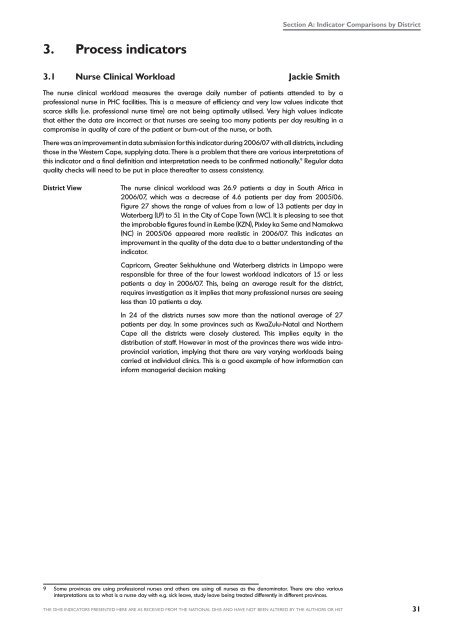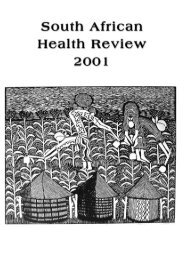DHB 2006/07 - Health Systems Trust
DHB 2006/07 - Health Systems Trust
DHB 2006/07 - Health Systems Trust
You also want an ePaper? Increase the reach of your titles
YUMPU automatically turns print PDFs into web optimized ePapers that Google loves.
Section A: Indicator Comparisons by District<br />
3. Process indicators<br />
3.1 Nurse Clinical Workload Jackie Smith<br />
The nurse clinical workload measures the average daily number of patients attended to by a<br />
professional nurse in PHC facilities. This is a measure of efficiency and very low values indicate that<br />
scarce skills (i.e. professional nurse time) are not being optimally utilised. Very high values indicate<br />
that either the data are incorrect or that nurses are seeing too many patients per day resulting in a<br />
compromise in quality of care of the patient or burn-out of the nurse, or both.<br />
There was an improvement in data submission for this indicator during <strong>2006</strong>/<strong>07</strong> with all districts, including<br />
those in the Western Cape, supplying data. There is a problem that there are various interpretations of<br />
this indicator and a final definition and interpretation needs to be confirmed nationally. Regular data<br />
quality checks will need to be put in place thereafter to assess consistency.<br />
District View<br />
The nurse clinical workload was 26.9 patients a day in South Africa in<br />
<strong>2006</strong>/<strong>07</strong>, which was a decrease of 4.6 patients per day from 2005/06.<br />
Figure 27 shows the range of values from a low of 13 patients per day in<br />
Waterberg (LP) to 51 in the City of Cape Town (WC). It is pleasing to see that<br />
the improbable figures found in iLembe (KZN), Pixley ka Seme and Namakwa<br />
(NC) in 2005/06 appeared more realistic in <strong>2006</strong>/<strong>07</strong>. This indicates an<br />
improvement in the quality of the data due to a better understanding of the<br />
indicator.<br />
Capricorn, Greater Sekhukhune and Waterberg districts in Limpopo were<br />
responsible for three of the four lowest workload indicators of 15 or less<br />
patients a day in <strong>2006</strong>/<strong>07</strong>. This, being an average result for the district,<br />
requires investigation as it implies that many professional nurses are seeing<br />
less than 10 patients a day.<br />
In 24 of the districts nurses saw more than the national average of 27<br />
patients per day. In some provinces such as KwaZulu-Natal and Northern<br />
Cape all the districts were closely clustered. This implies equity in the<br />
distribution of staff. However in most of the provinces there was wide intraprovincial<br />
variation, implying that there are very varying workloads being<br />
carried at individual clinics. This is a good example of how information can<br />
inform managerial decision making<br />
<br />
Some provinces are using professional nurses and others are using all nurses as the denominator. There are also various<br />
interpretations as to what is a nurse day with e.g. sick leave, study leave being treated differently in different provinces.<br />
THE DHIS INDICATORS PRESENTED HERE ARE AS RECEIVED FROM THE NATIONAL DHIS AND HAVE NOT BEEN ALTERED BY THE AUTHORS OR HST 31

















